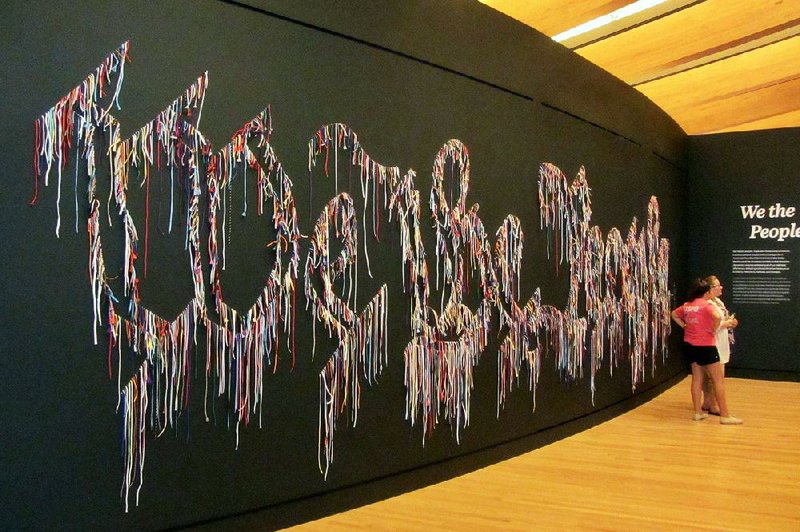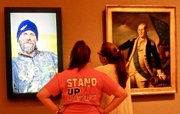BENTONVILLE -- An iconic portrait of George Washington by Charles Willson Peale has a new neighbor -- a time-warping interloper -- this year at Crystal Bridges Museum of American Art.
The oil painting from the early 1790s, depicting the Father of His Country as commander of the Continental Army, now hangs in one of two Early American Art galleries next to a very recent high-definition video piece. Created in 2013 by Susie J. Lee, the glowing image depicts Johnny, a bearded oil-field worker sporting a knit cap.
This pairing is among assorted eye-grabbing juxtapositions in the revamped Early American area at the world-class Northwest Arkansas museum created by multibillionaire Alice Walton.
Opened in November 2011 to wide acclaim and regularly thronged with visitors, Crystal Bridges aims to avoid resting on its popularity. That accounts for the Early American transformation and lesser changes in the Contemporary galleries.
Near the matchup of George and Johnny hangs another head-scratching pair of portraits: Alfred Henry Maurer's oil painting Jeanne from 1904 depicts a demure image of French model Jeanne Blazy in a floor-length white dress and long fur stole. Next to her, Jordan Casteel's oil work from 2016 shows Jared, a black teenager in Harlem. He is sitting on a skateboard and wearing jeans with a prominent knee hole.
The new Early American layout, first substantial rearrangement of Crystal Bridges' permanent collection, departs sharply from the mainly chronological display familiar to visitors before this spring. That's clear from the first work dominating the first gallery -- a wall-size installation crafted just three years ago by Nari Ward. Titled We the People, it spells out the first three words of the U.S. Constitution in shaggy shoelaces.
A panel in Spanish as well as English, bilingual like all the revised postings in the two galleries, conveys a forceful message of inclusion devolved from the Constitution: "The guiding ideals and aspirations outlined within it, however, excluded many -- essentially guaranteeing equality only to white men. Much has changed since the Constitution's ratification, and over time these rights continue to expand."
The panel goes on to assert that "there is no single narrative of American art and history. Multiple perspectives, stories and experiences continually shape the nation's identity. As you walk through the galleries, consider the art from all angles. What was happening at the time the artist made the artwork? How does the art carry meaning today? Whose perspectives and stories are missing?"
Curator Mindy Besaw, during the unveiling of the revised galleries, said the new displays "reflect the beauty, complexity and contradiction that comprise American art and stories both past and present. To better represent multiple perspectives and experiences, we've borrowed Native American art, folk art and Spanish Colonial art from other museums and collections. In addition, we're including artwork and objects that offer a few surprises along the way -- helping visitors to see their favorites in a new light and reconsider American art and experience."
A museum guard told a recent visitor that audience reactions to the new Early American presentation have varied, with many people welcoming the multicultural innovations and added information, while others have voiced preference for a more traditional and less didactic approach.
Changes are much less striking in the two Modern Art galleries, where Spanish text has yet to be added to the information panels. But the revisions also tend to focus on multicultural perspectives that may challenge traditional thinking. Whether that is the best way to go for a museum that has become one of the world's premier art collections remains to be seen.
Through Sept. 3, Crystal Bridges visitors can also take in "The Beyond: Georgia O'Keeffe and Contemporary Art." The temporary exhibition displays 30 of the legendary artist's lustrous paintings along with the work of 20 emerging artists depicting similar themes. There is a $10 charge to museum non-members 18 and older.
Crystal Bridges Museum of American Art, 600 Museum Way, Bentonville, is open 10 a.m.-6 p.m. Saturday-Sunday, 11 a.m.-6 p.m. Monday, 11 a.m.-9 p.m. Wednesday-Friday. General admission is free. For details, visit CrystalBridges.org or call (479) 418-5700.
Style on 08/14/2018


